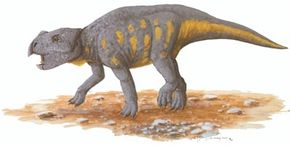BAGACERATOPS (BAG-ah-SAIR-ah-tops)
Period: Late Cretaceous
Advertisement
Order, Suborder, Family: Ornithischia, Marginocephalia, Protoceratopsidae
Location: Asia (Mongolia)
Length: 5 feet (1.5 meters)
Dinosaur Image Gallery
Bagaceratops rozhdestvenskyi was a small protoceratopsian with a big name: "baga" is the Mongolian word for "small," "ceratops" means "horned face," and the species name is in honor of Russian paleontologist A. K. Rozhdestvensky. Bagaceratops was discovered in the Gobi Desert of Mongolia in the early 1970s by the Joint Polish-Mongolian Paleontological Expeditions. Specimens of Bagaceratops are at the Paleobiological Institute in Warsaw.
Bagaceratops was one of the smallest and most primitive of the known proto-ceratopsid dinosaurs. Very little is known about the skeleton of Bagaceratops, as only a few fragments were found. It was probably similar to that of Protoceratops. However, paleontologists did find partial to nearly complete skulls of both juveniles and adults. One of the tiny juvenile skulls is only about the size of a golf ball. The skull of Bagaceratops had a short, low snout that was topped by a nasal "boss," or bump, rather than a horn. The neck frill was triangular and very short, and it had no openings (fenestrae). It had only ten grinding teeth in each jaw, and no teeth in its beak. One unusual feature of Bagaceratops was a large opening on each side of its snout.
Other animals that lived with Bagaceratops included the carnivorous dinosaurs Velociraptor and Oviraptor, as well as ankylosaurs, lizards, and small mammals.
Advertisement
